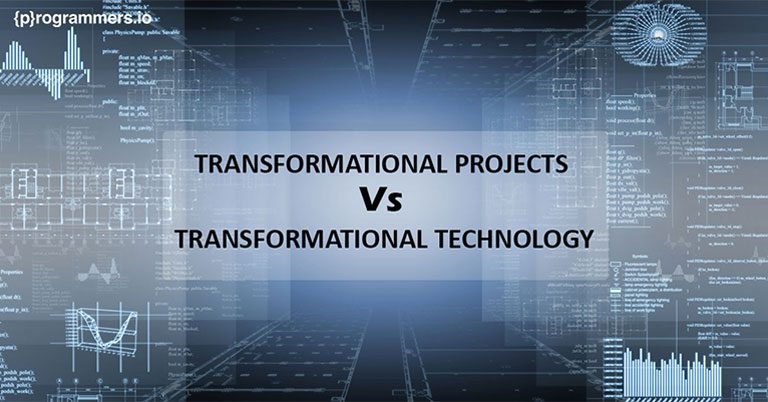The digital transformation started as quite an interesting revolution that had the wheels to change multiple industries at one time. While the transformation is still a work in progress, the term itself has become a buzzword that has lost the intent and the purpose behind it over time. Companies discuss the term without any actual purpose or definition behind it. Even teams surface the idea of a digital revolution from time to time without actually clarifying the idea and purpose behind it.
The initial days of the transformation saw many organizations drop old ways and move beyond legacy systems to the world of Edge and cloud computing. However, complacency has caught up with the pace of change to put a shroud of doubt over what the transformation entails and how organizations can realistically move towards it. Now, leading your strategy on the basis of a ‘digital transformation’ brings a lack of direction, as the term is ineffective today.
Leading your digital strategy on an outdated buzzword can have a couple of major consequences. To begin with, a strategy based on a buzzword is hard to follow and interpret for the team. The out of the box approach may not be doing enough to capture team interest. Also, since the term has broadened to encapsulate multiple definitions, the meaning you host of the transformation may be different than what your team does.
Secondly, relying on poorly defined strategies can put to doubt your position as a leader. Teams that have a clear set of goals and don’t rely on buzzwords tend to be a lot more effective in nature. The metaphorical desert of buzzwords comes without a compass, which is why staff members might find it hard to keep track of the change.
In this article, we lend some clarity to the sea of obscurity and explain the difference between transformational projects and transformational technology. Both these terms might be duplicated, but there is a world of difference between them.
The Digital World of Transformation
The lack of clarity is particularly felt when teams talk of a concrete digital transformation. There are two contrasting perspectives that users can entertain here. For some members of your team, a digital transformation could mean the adoption of transformative technology based on machine learning and AI. The focus behind the application of this technology is to create interesting tech-based solutions for consumers.
Others in your team might focus more on the transformation part of the digital revolution. These users might think of the digital transformation as a move into a concentrated zone where digital techniques are used to transform a business. Although there is a significant overlap between the both of them, a typical digital revolution targets two different outcomes in the same organization.
If you go by the first line of thinking, you will be tempted to think that the technology is to be applied to business parts that haven’t been updated and are yet to be merged with tech measures. For instance, a power company may use new tech solutions to improve their inspection and monitoring of power lines. The company might replace old measures to use AI, ML and drone cameras together to find out errors in power lines. While the previous ways of inspecting power lines achieved the same purpose, they were inefficient and not as fast as the current ones.
Carrying on from the example above, the cool factor of the new technology barely exists if you just use tech solutions to reach old outcomes. Tech leaders have believed in finding better and cheaper alternatives all time – so, where is the novelty of the digital transformation.
Building a Connected Enterprise
Transformational projects can go beyond transformational technology to help build a connected enterprise. Connected enterprise is coming up as a viable option for helping enhance the customer experience. Enterprises are currently on the lookout to enhance operational agility by connecting employees and workers to technology oriented processes. An enhanced customer experience is the ending block of a chain started through the efficiency of a connected enterprise.
Organizations can leverage the idea of a connected enterprise to:
- Use advanced analytics and data to full effect. Decision making from advanced analytics can be tricky, but it is worth the results.
- Offer enhanced experiences to all customers to improve results and create organizational synergy.
- Enhance organizational growth. Growth is one of the most primary objectives for organizations, and a connected enterprise can help you achieve that.
- Create a connection between customers, suppliers, partners and employees. Everyone is connected and there are no silos
- To assist the connectivity between different departments
A connected enterprise can only prove successful for you if you consider these important aspects of change:
- Processes: All your processes need to be updated for better, more efficient operations
- Content: Your data needs to be revolutionized.
- Communication: Connectivity and communication between all employees and stakeholders should increase.
Advantages of a Connected Enterprise
A connected enterprise opens your doors to tons of opportunities. For starters, a connected enterprise can help you in obtaining a complete understanding of your customer. Based on that understanding, you can help group your customers.
Additionally, this concept can help break the lack of communication between the front and back offices. Both offices will now be better connected and in a better position to make decisions.
Lastly, organizations will be able to enhance the customer experience and will see a growth in revenue down the line. This will be a result of satisfied customers.
Conclusion
Companies are currently undergoing serious digital transformations, leading to the notion of a connected enterprise. The difference between transformational projects and technologies can help align all your departments, people and data with technology is an excellent way to accelerate your trudge towards a digital transformation and provide your customers with a much better CX.




